The Brass Tacks of Steampunk
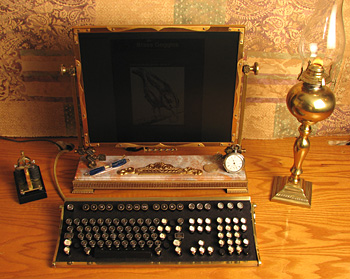 Jake von Slatt's desktop PC mod is an example of steampunk design, featuring brass, marble and a keyboard modified with typewriter keys.
Jake von Slatt's desktop PC mod is an example of steampunk design, featuring brass, marble and a keyboard modified with typewriter keys. Photograph courtesy of Jake von Slatt
Contraptors, mad scientists, tinkerers, inventors, gadgeteers---the vernacular used to describe the leaders and innovators of "steampunk" art echoes a place where machines were widely powered by steam, DIY inventors are rockstars and dirigibles meander through the air. But one common thread shared by this new wave of artists is their affinity of brass and copper as their tools of choice.
A tongue-in-cheek corner of the "cyberpunk" universe, "steampunk" is a subculture that arose in the late 1980s to denote artwork-primarily sci-fi fiction at first-inspired by the Victorian period that sowed the seeds of invention for the industrial era. In the past four years, inventors have been bringing this little bit of sci-fi to life, sending word of their reactions out to the blog-happy masses.
One such posterboy of the steampunk world, who goes by Datamancer, is best recognized for his modifications of desktop computers, bass amps and keyboards outfitted with Underwood typewriter keys. He's transformed entire desktop PC setups-from the brass LCD plate to the refurbished armchair-to look like they fit in a world of gaslight and brass goggles.
"Historically," says Datamancer, "the Victorian 'gentleman'-i.e. anyone wealthy enough to not actually need to work for a living-was expected to have several DIY intellectual pursuits, lest he be labeled an idle lay-about." They had money and the time to build, make and innovate, and thrust amazing inventions into the public realm that influenced the modern computer and propelled the Industrial Revolution. A romantic story, no?
Steampunk fans seem to think so. Modern-day inventors are embracing this earnest time in history, mixing a strong sense of nostalgia with the rods, gears, belts and brass-often incorporating technology. Also described as "Neo-Victorianism," steampunk gadgeteers marry Victorian aesthetic principles with modern sensibilities and technologies, complementing them with an array of Victorian-era fiction, art and utilitarian objects, many made of copper or brass.
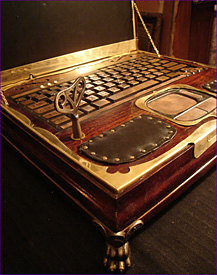 Steampunk Laptop by Datamancer
Steampunk Laptop by Datamancer Photograph courtesy of Datamancer
Steampunk's builders are revolutionizing the aesthetics of modern technology-which according to Magpie Kiljoy, an editor of Steampunk magazine, "is homogeneous." Prolific artists are modifying or "modding" the technologies we take for granted, eschewing plastic space-bubble designs for brass-plated LCD screens, toothy cogs, and mahogany-stained wood. What results from their efforts seem to come from an alternate version of history, as though they were natural complements to an electrically-powered 19th century.
Datamancer believes the common DIY sensibility among those in the steampunk community is the glue that binds them together. There is a sense of eagerness among the community to open-source the design methods, with most of the design processes boldly displayed on the inventor's website with step-by-step commentary with photographs to guide the novice along.
Having also redesigned classic cars, antique furniture, lamps and iPods, Datamancer is not one to rest on his laurels. He is supremely auto-didactic, and appreciates the accessibility of the technology in the 1800s, which consisted primarily of steam engines, rods, belts and gears. In his childhood he fabricated his own custom toys from foil, toothpicks and LED lights. Now he continues to work with several components at once, often electrics, wood, copper and brass. Although his creations look anything but simple, he loves the idea that machines can be traced out by eye as opposed to the coded technology in machines and computers today. "[It] is a lot more direct and intimate connection with the machine than looking at an Integrated Circuit or microprocessor and trying to guess what sort of code might be buried inside," he says.
His approach to good design is thoughtful, and he asserts that aesthetic elements should be functional as much as they are beautiful. While other builders may add pipes, rods and copper assemblage art to an object and then call it steampunk, Datamancer's designs are planned around the functional psychology of a device.
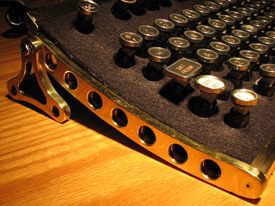 A close-up of Jake von Slatt's desktop pc mod and its hand-decorated brass elements along the base of the computer monitor.
A close-up of Jake von Slatt's desktop pc mod and its hand-decorated brass elements along the base of the computer monitor. Photographer courtesy of Jake von Slatt
"For instance," he elaborates, "I often add small doors that can cover the LCD [monitors] of my PCs which are functionally superfluous by today's standards." His "Archbishop PC" modification features dramatic, red stained-glass doors, which Datamancer says enhances the religious-themed "reliquary" concept of the overall look. He always has a story behind his design choices, and embraces this one regarding the history of our first relationship to TV: "When televisions first appeared consumers had the creeping sensation that the animated, lifelike characters… were actually looking back at them. Manufacturers later added small doors to some of the early models so that consumers could shut out the actors on television." He adds, "Small details like these are what make a mod or device historically believable."
The "functional while beautiful" design concept extends to the use of brass and copper in steampunk circles. Jake von Slatt, another prolific steampunk contraptor who specializes in brass-plated PC mods and copper and brass etchings, echoes affinity for brass and calls it "blue collar gold."
Datamancer agrees. "The cupreous metals are structurally rugged, thermally and electrically conductive, tarnish-resistant, anti-microbial, non-sparking, and friction-resistant," he explains with a flourish. He incorporates these metals into most of his designs because they are historically relevant, easy to work by hand and offer a structural element that "is attractive enough to stand on [its] own."
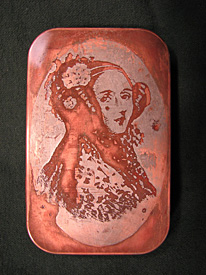 A copper electroplated etching on a found object--an Altoids tin--by Jake von Slatt.
A copper electroplated etching on a found object--an Altoids tin--by Jake von Slatt. Photograph courtesy of Jake von Slatt
One of his most beautiful modifications, the "Steampunk Laptop," first appears to be a richly carved box with engraved brass accents and claw feet. When opened, a familiar LCD screen and QWERTY keyboard with uniquely engraved brass keys stares back. Looking at the closed box with a glittering display of clockwork gears under glass, you would never know that a Hewlett-Packard ZT1000 laptop is inside. Datamancer has taken care to preserve the functionality of the computer so that it remains familiar to the user; he has even carved out a wooden drawer for the CD-ROM and added leather wrist rests. The laptop is powered up using an antique clock-winding key that turns a racheting switch, constructed from old clock parts.
Although all the elements usually desired in a laptop-lightweight, portable, able to take a few hard knocks-are lost in his modification, it has gained an element of whimsy. He incubated months for the project, planning each detail before setting mind to matter. "Rather than trying to reinvent the device," Datamancer explains, "I merely tried to imagine what it would look like if the same device were built in the Victorian era, with all accompanying pomp and embellishment."
His current project involves one of the two best-loved personalities in steampunk, Charles Babbage and Ada Lovelace. Credited as the inventors of the first mechanical computers, they birthed the original concepts for the functions of the modern computer; The Analytical Engine, the latter of the two they designed, had the ability to program and store numbers for use in calculations. Although it was never built during their lifetimes, "it was wildly ambitious," Datamancer says, "and is the quintessential steampunk contraption aesthetically and conceptually." His latest PC, nicknamed "The Clacker," is inspired by the 3-ton brass machine of finely interwoven cogs, gears, rollers and levers. Datamancer is making this his most ambitious project as well, featuring a bristling array of spinning brass machinery visible through a curved glass panel. The entire PC-mod will include a leather-topped table, antique phonograph horn with PC speakers.
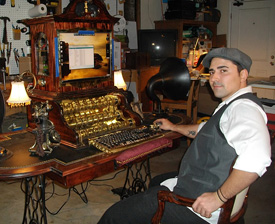 Datamancer with his prototype of the project inspired by the Charles Babbage Analytical Engine, the "Clacker".
Datamancer with his prototype of the project inspired by the Charles Babbage Analytical Engine, the "Clacker". Photograph courtesy of Datamancer
Jake von Slatt thrives on repurposing materials and is also inspired by Ada Lovelace, as demonstrated by a recent piece that depicts her image in copper on an Altoids mints tin titled "Ada-Altoid." He is among a growing group of green gadgeteers interested in recycling and reusing materials. Brass lamps are one of von Slatt's preferred sources of material, and he is currently building a foundry furnace for casting his future pieces.
It's hard to say what the future of steampunk may hold. Some say it may go the way of punk, skater, goth or rockabilly masquerading as a subculture that has, in actuality, become mainsteam. But Datamancer hopes steampunk won't lose its original core ideals. "I really hope that some of the DIY spirit remains…because I really think that's the bonding element that makes it such a beautiful community."
Also in this Issue:
- The Brass Tacks of Steampunk
- Erickson Birdhouses: Weathering the Seasons Beautifully
- Copperhand Studio: In Partnership with Nature
- Ruth Shapiro: Symbols of Judaica in Metal
- Christie's Presents: Historical Design Reflects-The East 61st Street Years
